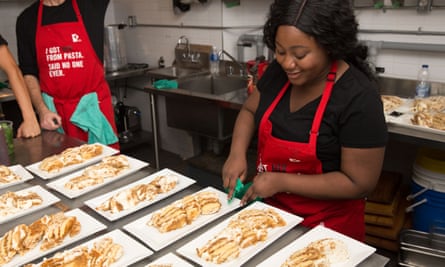Until recently, few of the chefs had ever set foot in a restaurant kitchen. Now they were slicing up hunks of skirt steak and gently coaxing pomegranate seeds out of their peels as they readied an elaborate four-course dinner for more than 100 patrons.
The 14-person team was working to open June’s, a unique pop-up restaurant in Toronto that is the world’s first eatery in which all of the kitchen staff are HIV positive.
“We really wanted to be able to challenge the stigma that still exists around HIV,” said Joanne Simons of Casey House, Canada’s first and only standalone hospital for people living with HIV/Aids. The idea of a restaurant was born out of a recent poll that suggested only half of Canadians would knowingly share or eat food prepared by someone who is HIV positive.
The event comes as, on average, seven Canadians a day are diagnosed with HIV, a rate that has decreased only slightly since the 1980s.
When Casey House opened in 1988, its first client was brought to the facility flanked by paramedics in hazmat suits. Despite huge advances in treating the disease and better understanding of how it is contracted, much of the stigma of that era endures today, said Simons. “I think that there’s still this lingering notion that if I have regular human contact with somebody with HIV, I may contract it – and it is still a death sentence.”

She pointed to some of the reaction on social media after the pop-up was launched as an example. But with these comments came an invaluable opportunity to publicly address some of the myths that persist today around HIV.
“There were a lot of questions about what happens if somebody cuts themselves in the kitchen and they’re HIV positive,” said Simons. “We manage that like anybody would in a kitchen: you make sure you provide first aid, you clean up the area, you throw away whatever has been touched by the blood and you clean the surfaces. We would do that regardless of whether you have HIV or not – that’s just common sense.”
Others wondered about the risk of transmission. “There’s absolutely no risk that somebody can contract HIV from sharing a meal,” she said. “HIV doesn’t live well out of the body for any length of time and through the cooking the virus dies.”
In the weeks leading up to the event, the 14 people recruited to staff the kitchen spent hours with the Toronto chef Matt Basile to design a menu. As they geared up to prepare dishes that ranged from a northern Thai potato leek soup and Arctic char pappardelle, Basile trained them in food preparation.
Muluba Habanyama, a cook who lost both her parents to the disease, wondered what they would have thought of the restaurant. “I know that if they were alive and seeing this it would have been unreal to them,” said the 24-year-old. “Growing up, I knew I was positive, but I also knew it was a secret you kept within the family.”
As a child she fretted during sleepovers that the other kids would spot her taking medications – and experienced first-hand how perceptions shifted when she revealed her secret. “A mentor of mine made me eat off paper plates and paper cups while her and her husband ate off glass plates and glasses. I was about seven years old … It hurt me a lot.”
She spiralled into depression at the age of 19 after losing her second parent to the disease. “Me and my sister had to plan [my mother’s] funeral. And people would come and ask what happened. And we would make up stories,” she said. “So I didn’t really get to grieve properly because I was making up lies and stories and couldn’t really tell my friends and extended family what really was going on.”

The experience eventually pushed her to openly acknowledge her status in 2014. “I just know that I never want to go into that darkness again,” she said. “But I still get very nervous about it because you don’t know how that’s going to change the mood or change the environment. You don’t want to just be the girl with HIV.”
The sentiment was echoed by Trevor Stratton, who on Monday was manning the garnish station. Now 52, he was diagnosed 27 years ago and has been HIV positive for more than half of his life. “Try and get a date when you’re HIV positive,” he said. “I always disclose, even on dating apps online. People don’t want to talk to you – the first thing they’ll say is ‘how did you get it?’”
Stratton, whose mother is an indigenous Canadian, has for years worked to raise awareness and combat HIV/Aids among Aboriginal populations in Canada. “We have more than twice the national average in terms of HIV incidence,” he said.
In the province of Saskatchewan, infection rates in recent years have mirrored those of some developing countries. “Most of those people are indigenous people and most of them are getting HIV through injection drug use. Which is tied to trauma, residential school system and that whole history we have in Canada,” said Stratton.
He pointed to the stigma that already burdens those diagnosed with HIV. “And then if you’re indigenous or maybe African, Caribbean or black, there’s many layers, intersections of stigma and discrimination.”
Stratton had jumped at the chance to participate as a cook in this week’s restaurant, describing it as crucial chance to highlight an issue that has been largely overlooked in recent years. “We need help, we need allies, we need to be recognised as a key affected population,” he said. “We’re invisible. And that’s our work – to try and get us on the map.”
